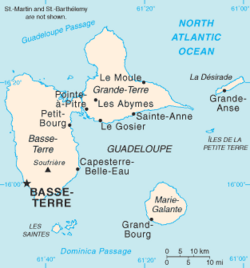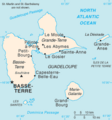Action of 22 January 1809 facts for kids
Quick facts for kids Action of 22 January 1809 |
|||||||
|---|---|---|---|---|---|---|---|
| Part of the Napoleonic Wars | |||||||
|
Location of the action of 22 January 1809 |
|||||||
|
|||||||
| Belligerents | |||||||
| Commanders and leaders | |||||||
| Strength | |||||||
| 2 frigates 1 sloop |
1 frigate | ||||||
| Casualties and losses | |||||||
| 3 killed and wounded | 26 killed and wounded 1 frigate captured |
||||||
The action of 22 January 1809 was a small naval battle. It happened near the Caribbean island of Guadeloupe during the Napoleonic Wars. This fight was part of a larger plan by the British. They wanted to block French islands like Guadeloupe and Martinique. This would stop ships from France bringing supplies.
The British Navy wanted to cut off these islands. This was to prepare for invasions later on. France tried many times to send supplies to its colonies. They used fast ships called frigates. But often, these ships were caught by the British.
One French frigate, the Topaze, tried to bring flour. It sailed from Brest to Cayenne. But Portugal, a British ally, had already captured Cayenne. So, the Topaze went to Guadeloupe for safety. It hid near the shore under French guns.
On January 22, 1809, the British ship HMS Hazard found the Topaze. It was anchored off Pointe-Noire. Two other British frigates joined the attack. Captain Samuel Pechell led them in HMS Cleopatra. The British ships were stronger. They captured the Topaze and its cargo. This happened despite heavy fire from a French gun battery on shore.
The British ships were part of a fleet. This fleet was getting ready to invade Martinique. The invasion started just six days after the Topaze was captured. The British successfully took Martinique in a few weeks.
Why This Battle Happened
By 1808, the Napoleonic Wars had been going on for five years. The British Royal Navy was very strong at sea. They blocked French ports to stop trade and movement. British ships, like fast frigates and large ships of the line, watched every important French harbor. Smaller ships watched less important areas.
This strategy was used across the French Empire. It was especially important in the West Indies. British trade routes there were often attacked by French warships. Because of this, the French colonies, like Martinique and Guadeloupe, faced problems. Their food, military supplies, and morale became very low.
Messages asking for help were sent to France. But many were caught by British ships. This made the Admiralty decide to invade the French colonies. So, in late 1808 and early 1809, British forces were sent. They took over smaller colonies. A large army and navy gathered at Barbados. This force was led by Sir Alexander Cochrane. They were ready to attack Martinique.
In France, leaders heard about the problems in the West Indies. They sent ships with food and military supplies. But some ships were caught. For example, the frigate Thétis was captured in November 1808. Still, some ships made it through. More supply ships were prepared.
One of these was the frigate Topaze. It was ordered to carry 1,100 barrels of flour to Cayenne. It also carried military supplies and 100 soldiers. Captain Pierre-Nicolas Lahalle commanded the ship. The Topaze was only three years old and had 40 heavy guns.
In December 1808, the Topaze left Brest. It sailed across the Atlantic Ocean. It met the British frigate HMS Loire. The Loire fired on Topaze, but could not catch it. The French ship reached the Caribbean with only minor damage.
On January 13, 1809, the Topaze neared Cayenne. Lahalle was surprised to see the small British ship HMS Confiance. It came out of the harbor. Lahalle realized Cayenne was under British control. He turned and sailed north. He worried stronger British forces might be nearby. Actually, Confiance was the only British ship there. It was lightly armed with only 47 men. Cayenne had been captured three days earlier. A British and Portuguese force had taken it.
The Battle Unfolds
With Cayenne under British control, the Topaze quickly sailed for Guadeloupe. Captain Lahalle wanted to deliver his supplies and soldiers there. Then he planned to return to Europe. For nine days, the Topaze sailed without seeing any British warships.
At 7:00 AM on January 22, the Topaze was spotted. It was approaching Guadeloupe from the southwest. The British brig HMS Hazard, led by Captain Hugh Cameron, saw it. Hazard was part of a British group watching the French islands. Cameron ordered his brig to approach the much larger French frigate.
Within two hours, two more British frigates joined Hazard. These were HMS Cleopatra under Captain Samuel Pechell and HMS Jason under Captain William Maude. The British ships were smaller than Topaze. But together, they had a big advantage over the heavily loaded French ship.
Hazard approached from the northeast. Cleopatra came from the southeast. Jason came from the south. Lahalle had only one way to go: east, directly towards Guadeloupe. By 11:00 AM, the Topaze was about 200 yards (180 m) from shore. It was hiding in the bay off Pointe-Noire. A small gun battery on shore protected this spot. Soldiers from the island's army manned the battery.
Over the next three and a half hours, the British ships slowly moved towards the bay. Light winds made it difficult. The wind grew stronger at 2:30 PM. By 4:30 PM, Cleopatra was close enough. The Topaze opened fire on her from 25 yards (23 m). Captain Pechell moved Cleopatra into a good spot. He began firing at the Topaze's front. He shot away one of the French ship's anchors. This made the Topaze swing towards the shore. Cleopatra could then fire repeatedly along the length of Lahalle's ship.
The Topaze was badly damaged. It could not fight back well. The only real danger to the British ships came from the shore battery. By 5:10 PM, Jason and Hazard had joined Cleopatra. Hazard fired at the battery. Jason fired on the other side of the French ship, causing more damage.
Captain Lahalle saw that his situation was hopeless. He surrendered at 5:20 PM. As the French flag came down, many French soldiers and sailors tried to escape. They jumped overboard and swam for the shore. Some did not make it. The remaining survivors, including Lahalle, were about 300 men. They became prisoners of war. The damaged Topaze was towed out of the bay. It was taken to a British port for repairs.
What Happened Next
The British had very few casualties. No one was hurt on Jason and Hazard. The French battery on shore also had no casualties. Cleopatra had only two men killed and one wounded. Its masts and ropes were badly cut. The French crew who did not try to flee had light losses. Twelve were killed and 14 wounded. The French frigate was badly damaged, especially its hull. It needed many repairs before it could join the Royal Navy. It was renamed HMS Alcmene.
On January 28, Cochrane's fleet left Barbados for Martinique. This fleet included Jason, Cleopatra, and Hazard. They arrived two days later. They successfully landed troops at three places on the island. Within a week, the British controlled almost all of Martinique. Only Fort Desaix held out. It surrendered after three more weeks of heavy bombing.
The next month, a large group of French ships arrived. But they could not help Martinique. They anchored in Îles des Saintes, a small group of islands near Guadeloupe. Cochrane's ships blocked and attacked them there. In the Action of 14–17 April 1809, the French were defeated. The French ship of the line D'Hautpoul was captured. The other French ships had to return to Europe.
Two French frigates reached Guadeloupe. But both were captured later. France tried to resupply Guadeloupe again in 1809. A French group of ships, led by Commodore Francois Roquebert, captured a British frigate in December 1809. However, this French group was stopped by a British blockade near Guadeloupe. In the action of 18 December 1809, the French were defeated. Two French frigates were destroyed. Two others had to return to Europe without reaching their goal.
Guadeloupe was later invaded in January 1810. It was captured by the British. This ended France's direct involvement in the Americas during the Napoleonic Wars.
Images for kids



